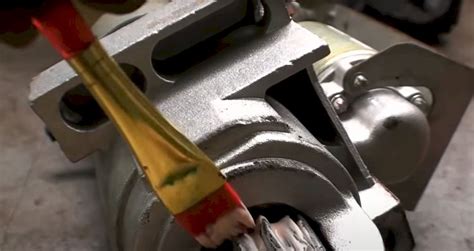Starter Shim Installation: A Step-by-Step Visual Guide
Starting your car shouldn't be a struggle. A common culprit behind a sluggish or non-starting engine is an improperly engaged starter motor. Often, a simple starter shim can resolve this issue. This guide provides a clear, step-by-step visual walkthrough of the installation process. While we can't provide actual images here, we'll describe the process in such detail you can easily follow along with your own photos or a workshop manual specific to your vehicle. Remember, safety first! Always disconnect the battery's negative terminal before starting any work on your vehicle's electrical system.
Understanding the Need for a Starter Shim
Before diving into the installation, let's understand why you might need a starter shim. The starter motor engages with the flywheel (or flexplate in automatic transmissions) to crank the engine. If there's too much distance between the starter and the flywheel, the starter bendix gear might not fully engage, leading to a clicking sound instead of the engine turning over. A shim, a thin metal spacer, remedies this by reducing the gap, ensuring proper engagement.
Why is my starter not engaging properly?
This is a common question, and several factors can contribute to poor starter engagement:
- Worn starter components: Over time, wear and tear on the starter motor itself, including the bendix gear, can create excessive distance.
- Flywheel/flexplate wear: Similar to the starter, wear on the flywheel or flexplate's teeth can affect engagement.
- Engine misalignment: In rare cases, engine misalignment might contribute to the problem.
- Incorrect installation: Previous starter installations might have been performed incorrectly, leaving the starter too far away.
Identifying the root cause before shim installation is crucial. If the issue isn't solved by the shim, there might be a more significant problem requiring professional attention.
Step-by-Step Starter Shim Installation
Disclaimer: This guide provides general instructions. Always consult your vehicle's repair manual for specific procedures and torque specifications. Improper installation can damage your vehicle.
Tools You'll Need:
- Jack and jack stands (or ramps): For safe and stable access to the starter.
- Socket wrench and sockets: Appropriate for your vehicle's starter bolts.
- New starter shim: Ensure you have the correct thickness.
- Wrench or socket: To disconnect the battery.
- Gloves: Protect your hands.
- Safety Glasses: Always protect your eyes.
- Vehicle Repair Manual: This is essential!
Steps:
-
Disconnect the battery's negative terminal. This is the most important safety step.
-
Access the starter motor. This typically involves removing parts like the air intake, air cleaner housing, or other components obstructing access. Refer to your repair manual for precise instructions.
-
Remove the starter motor. Carefully disconnect any electrical connectors and remove the starter mounting bolts. Lower the starter carefully. Take pictures as you go to aid reassembly.
-
Inspect the starter and flywheel. Check for any signs of significant wear or damage.
-
Install the shim. Carefully place the shim between the starter motor and the engine block, ensuring it's properly positioned.
-
Reinstall the starter motor. Securely reattach the starter motor, ensuring proper alignment.
-
Reconnect the electrical connectors. Double-check all connections are secure.
-
Reconnect the battery's negative terminal.
-
Test the starter. Attempt to start the engine. If the problem persists, re-examine your work and consult a professional mechanic.
Troubleshooting
- Starter still doesn't engage: The shim might be the wrong thickness, or another issue exists.
- Starter engages but makes noise: Check for proper alignment and secure bolts.
- Engine cranks slowly after shim installation: The shim might be too thick.
Remember, if you are uncomfortable performing this task, consult a qualified mechanic. Improper installation can lead to serious damage to your vehicle.
This detailed guide provides a clear picture of starter shim installation. Remember to prioritize safety and consult your vehicle's repair manual throughout the process. Good luck!

